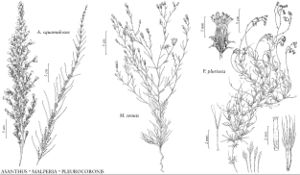Asanthus
Phytologia 24: 66. 1972.
| Taxon | Illustrator ⠉ | |
|---|---|---|
 | Asanthus squamulosus Malperia tenuis Pleurocoronis pluriseta | Linny Heagy Linny Heagy Linny Heagy |
Perennials or subshrubs, 30–60 (–100) cm. Stems erect, much branched. Leaves cauline; mostly opposite (distal sometimes alternate); ± sessile [petiolate]; blades 1-nerved (or nerves parallel, mostly linear to filiform [lanceolate] (distal usually filiform to scalelike), canescent, often with axillary, ± 4-ranked, canescent, fascicles of scale-leaves), margins entire, faces glabrous or puberulent, usually glanddotted. Heads discoid, in narrow, racemiform [corymbiform to paniculiform] arrays. Involucres ± obconic, 4–5 mm diam. Phyllaries persistent, 20–25 in 4–8 series, not notably nerved, lanceovate to oblong, unequal (herbaceous to scarious, becoming indurate). Receptacles flat, epaleate. Florets 8–14; corollas whitish, throats narrowly cylindric (lengths 6–8 times diams.); styles: bases not enlarged, glabrous, branches narrowly clavate (distally dilated, not notably papillose). Cypselae narrowly prismatic, (9–) 10-ribbed, scabrellous on ribs; pappi persistent, of 20–100 barbellate (at least distally) bristles in 1–3 series.
Distribution
sw United States, w Mexico
Discussion
Species 3 (1 in the flora).
Asanthus has been included within Steviopsis (see discussion under 404. Brickelliastrum).
Selected References
None.
Lower Taxa
"fine" is not a number.